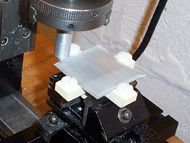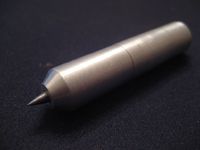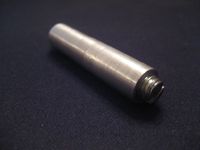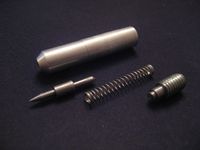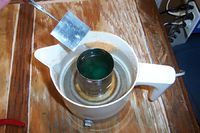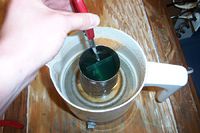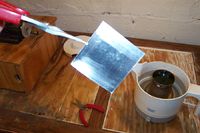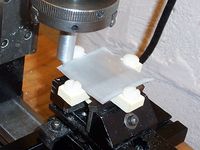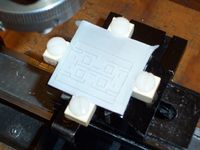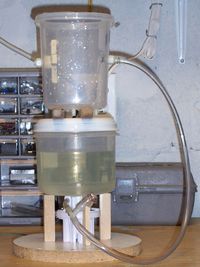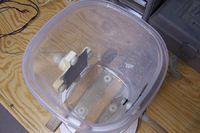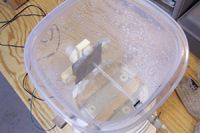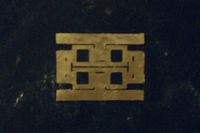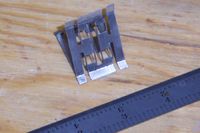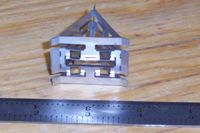Metal Etching Scriber
Release status: Experimental
| Description | A scribing toolhead for use in etching metal patterns.
|
| License | unknown
|
| Author | |
| Contributors | |
| Based-on | |
| Categories | |
| CAD Models | |
| External Link |
Introduction
Etching is a widely used fabrication process. Hobbyists routinely use metal etching and/or photo-etching for making printed circuit boards, stencils and (especially for model railroaders) mechanical models. Typically a pattern of etch-resist is printed on special paper and then transferred to sheetmetal or a copper-clad-board using ironing or some other process. There are also other methods that use pre-coated photosensitive metal plates (see See Also).
This project describes a simple method of applying etch-resist to plain sheetmetal, engraving a pattern in the etch-resist using an XYZ table, and chemically etching the metal to produce a functional mechanical part. None of these processes are new, but it can be difficult to find a combination of parameters that actually works. This information is presented to experimenters in the hopes that it will be useful, since it is a "known good configuration" that does indeed actually work.
The pattern to be etched can be created using a RepRap or other automatic XYZ plotter. This method has been used to make a prototype compliant mechanism. It may be useful for Automated Circuitry Making or for cutting out motor laminations from magnetic sheet steel.
Process Overview
In the experiment shown, 0.010 inch thick aluminum sheet was etched with a hydrochloric-acid-based etchant. Variations are possible by using different metals and etchants. There are also interesting possibilities using electrochemical etching, Electrochemical Machining, Electrical Discharge Machining, etc.
1. The scriber itself is nothing fancy, just an aluminum housing with a spring-loaded sharp steel point. You can buy similar things off-the-shelf (check McMaster for "automatic center punches"). In the experiments here, the scriber was held in a chuck on a manually operated Sherline mill. It is held in the chuck, but the spindle is not powered (it does not need to rotate but rotation won't hurt anything either). A scriber like this should work fine installed on RepRap.
2. Prepare the metal. In many etching and electroplating operations, cleaning the metal properly is the most difficult and essential step. Soap and fine-grit sand paper were acceptable for this work. A can of candle-wax chunks was melted in a hot water bath of a temperature about 100C. Note: molten wax is dangerous (see Safety). The aluminum was dipped once in the wax to get a thin uniform coating.
3. Scribe the pattern. The coated aluminum was mounted in a special frame for the etch tank and then clamped in a vise for creating the pattern. A single pass for each line is all that is needed. The scribe point should cut through the wax and leave a shiny scratch on the surface of the metal.
4. Prepare the etchant. The etching solution was made by adding 500mL of 20% hydrochloric acid to 600mL distilled water. This is a corrosive solution so use caution preparing and using it (see Safety). Wear goggles and gloves. When mixing, add small amounts of acid to the water while stirring. Do not use metal containers to mix this solution. It is ok to mix this up directly in the etching tank. 20% hydrochloric acid is available at many hardware stores, where it is often sold under the name "muriatic acid".
5. Fill the tank. A special etch tank was built out of plastic food containers and a surplus medical device pump. The pump circulates etchant and sprays it with moderate velocity directly at the metal being etched. In addition, the metal can be manually rotated in the frame to get a more uniform exposure to the etching spray. The spray system is important to get crisply etched lines that are uniform over the area of the part. The metal part inside the frame is loaded in the top container, and the etchant can be poured in. The top container can be covered during operation.
6. Etch! With etchant at room temperature, this part took about 45 minutes to etch through. The metal part was rotated by 180 degrees at 20 minutes, and then by 90 degrees at 40 minutes.
7. Rinse and de-wax the part. Excess wax can be removed from the part by rinsing it in the hot water bath. On cooling, the residue wax will harden and can be skimmed off the top of the water bath. Three etched parts were combined to make the final assembly.
Safety
Use the same safety procedures that you would in chemistry lab:
common sense
protective clothing (goggles, gloves, apron)
adequate ventilation
clean work area
Molten wax is dangerous, especially if it is superheated. The use of a double-boiler or water-bath makes it much safer to handle, but it still must be treated carefully. Numerous tutorials are around that explain safe procedure.
Hydrochloric acid will damage skin, eyes, clothing, etc. Wear goggles and gloves. When mixing, add small amounts of acid slowly to water and stir. This prevents sputtering and boiling that can occur when when water is added to acid.
During chemical etching, electrochemical etching, and electroplating small amounts of dangerous gas (chlorine, hydrogen, etc) can be released. Use adequate ventilation.
In general, be aware that when you are doing experiments with metal plating and metal etching, the chemical solutions left over afterward may be more dangerous than the ones you started out with. Be cautious and responsible when using, storing, and disposing your chemicals.
See Also
1. Bruce Simpson describes an interesting way to cut sheet metal electrochemically on his web site about pulse-jet engines. A pdf report is pdf here and a great youtube tutorial is here.
2. An example of photo-etch printed circuit boards.
3. An example of toner-transfer printed circuit boards.
4. An example of photo-etched mechanical models.
